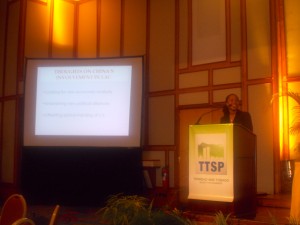 I am currently en route back to the United States from Trinidad and Tobago where I had the opportunity to present my research on China’s growing role in Latin America at the 2013 Caribbean Urban Forum. My planning colleagues from across the Caribbean and the world were very receptive to what I shared and I am excited to follow up on the partnerships and opportunities that were initiated as a result of today’s presentation.
I am currently en route back to the United States from Trinidad and Tobago where I had the opportunity to present my research on China’s growing role in Latin America at the 2013 Caribbean Urban Forum. My planning colleagues from across the Caribbean and the world were very receptive to what I shared and I am excited to follow up on the partnerships and opportunities that were initiated as a result of today’s presentation.
I am often asked how I came to be interested in this subject matter and the honest answer, like most of my life these past three years, is that I stumbled upon it. Last summer, several news outlets announced that China was creating a $10 billion infrastructure bank for Latin America and this immediately raised question for me in terms of who would oversee such an entity, how smaller Caribbean nations would access these funds, what China would get in return and the like. I went on to write my first Urban Times article on this but my curiosity led me to conduct a more in depth study of China’s activities in the region to-date.
The reality is that China has been actively engaged in Latin America and the Caribbean for about a decade now. It was until 2008, however, did China make its intentions explicit with the release of its Policy Paper on Latin America and the Caribbean. The document mainly addresses China’s political, economic and sociocultural aspirations for Latin American countries as well as its desire to engage in mutually beneficial relationships as one developing country to another.
It is important to note that China’s impact is not being felt evenly throughout the region when its relationships with larger South American countries are compared to China’s influence on the smaller Central American and Caribbean states. The goal of my presentation was to highlight these differences so that Caribbean urban planners and local officials could more proactively address China’s involvement in their countries.
For resource-rich countries such as Brazil, Venezuela or Argentina China’s economic priorities and desire for raw materials (such as various metals, oil and soybeans) dominate. Consider that China’s overall trade, primarily with these countries, was $10-13 billion in 2000 but grew to $143 billion by 2008. As a result, Pacific-facing countries have received substantial port, airport and road upgrades from China so that goods from the region could be transported back to China more quickly.
On the contrary, Central American and Caribbean who are without the natural resources China desires are most affected by China’s political motivations instead. China has strategically used infrastructure investments and various financial gifts as a tool to win over (or maintain) the allegiance of these smaller and more vulnerable nations away from Taiwan. The Caribbean has 11 of the 23 countries in the world that acknowledge Taiwan as an independent state and this stands in violation of China’s ‘One China Policy.’
While many island nations benefit from the roads, schools and hospitals that China builds, urban planners have to be at the forefront of monitoring the impact of these developments on the local communities that receive these projects. It may not be China’s intent to cause harm but ignoring long-term effects of Chinese investments in the region can lead to significant unintended physical consequences if poor site selection, no maintenance provisions or a lack of local management continues to define how China’s infrastructure activities are implemented. The last thing Caribbean planners want is to passively facilitate a future state of urban decline by not aggressively engaging with China today.
There are so many more interesting facets to share but I will stop here for now. Stay tuned in case I decide to follow up with a ‘Part Two’ of this discussion!


About The Author: Vanessa L.
More posts by Vanessa L.